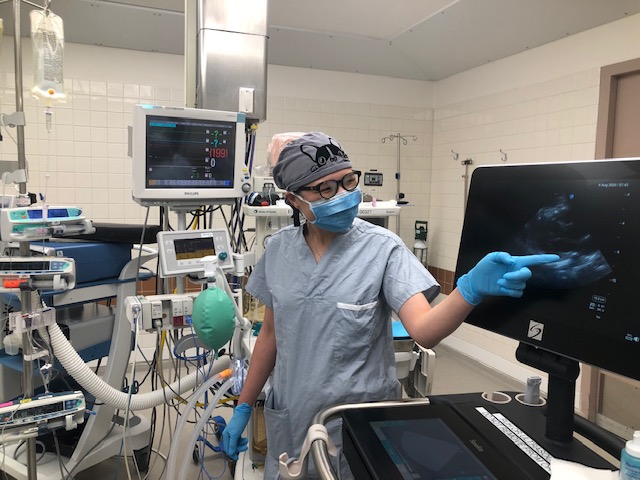
New research measures how anesthesiology residents develop ultrasound skills
Point-of-care ultrasound (POCUS) has emerged as a safe, non-invasive tool for physicians to optimize many types of care at the bedside — from a heart examination to lessening the pain of a total joint knee replacement.
By Kristen McEwenNow, anesthesiology residents able to receive training to learn more about POCUS, thanks to college-led research and a new curriculum.
“One of the concerns with POCUS is that you can’t just learn it in a one-time course,” explained Dr. Michelle Clunie, assistant professor in the College of Medicine and the Division Lead for Cardiac Anesthesia in Saskatoon.
“It is crucial to have adequate supervised training to learn not just the technical skills but also the appropriate indications, pitfalls and limitations. Residents need ongoing practice to gather the skills necessary to use POCUS,” she said.
Clunie has become a leader in point-of-care ultrasound (POCUS) during her 17-year career as an anesthesiologist. Though not initially trained in many of the uses of this technology, Clunie recognized the value of POCUS and the importance of proper training.
“Ultrasound has been used for more than 20 years by anesthesiologists. Early uses include transesophageal echocardiogram (TEE) assessment of the heart during cardiac surgery and guiding correct placement of local anesthetic nerve blocks and insertion of lines into vessels. It’s much safer to use ultrasound to put those lines in,” Clunie said.
Anesthesiologists routinely place arterial lines to monitor blood pressure in patients who are undergoing major surgery. POCUS enables anesthesiologists to accurately pinpoint the location to place difficult arterial lines and IVs.
POCUS technology and use are rapidly expanding, and it has become a required skill of anesthesiology residents. Heart and lung POCUS scans can help to quickly and accurately determine cause and guide management of low blood pressure or low oxygen levels during or after surgery. Ultrasound can also be used to look at whether the stomach is full or empty before an operation.
Clunie co-developed, with colleague Dr. Rob Perverseff, a POCUS curriculum for anesthesiology residents. With funding from the provincial Department of Anesthesiology Research Engagement (DARE) awards, Clunie led a research project to assess the competency and study the learning curve of residents enrolled in the new POCUS curriculum.
While using POCUS, anesthesiology residents demonstrate their competency in the following areas: image acquisition, insight and knowledge, image interpretation and integration of findings into clinical management.
The resident curriculum and research project involved collaboration with colleagues from the Departments of Anesthesia, Emergency Medicine, Internal Medicine and the Division of Non-Invasive Cardiology. Lori Mack, an experienced Registered Diagnostic Cardiac Sonographer along with POCUS-trained anesthesiologists, provide bedside instruction and collect data during the weekly resident training sessions with live simulated patients in the Clinical Learning Resource Centre (CLRC).
Dr. Paul Olszynski, director of clinical ultrasonography at the USask College of Medicine, noted that POCUS contributes to improved patient care from improving diagnostic accuracy, to making procedures safer.
“Personally, I strongly believe that POCUS belongs at the bedside any time it may benefit the patient … regardless of specialty,” Olszynski said.
At USask, multidisciplinary POCUS curriculum exists for most first-year resident programs in internal medicine, surgery, anesthesiology and emergency medicine, he explained. Clunie presented the findings of her team’s research at the Canadian Anesthesiologists’ Society’s virtual Richard Knill Research Oral Competition on June 20-21. It was one of the top-scoring abstracts selected from across Canada.
